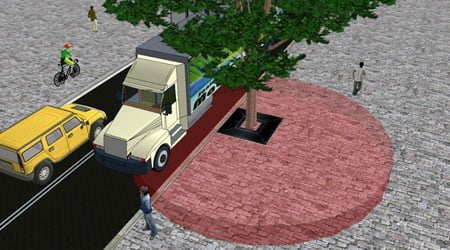Posted by admin on Thu, Jul 16, 2015 @ 1:02 AM
Do Healthy Trees need High Quality Soil?
 Soil for healthy trees require an adequate supply of loose, well aerated, moist and uncompacted soil structure in order to thrive. This enables their roots to obtain nutrients, oxygen and water – all essential for healthy tree growth.
Soil for healthy trees require an adequate supply of loose, well aerated, moist and uncompacted soil structure in order to thrive. This enables their roots to obtain nutrients, oxygen and water – all essential for healthy tree growth.
In highly urbanised areas often inadequate space is allocated for tree roots to develop. In addition the soil structure is frequently compacted through having to bear the weight of footpaths and roadways, pedestrians and traffic in general. As soil becomes compacted the voids between particles, that hold water and oxygen, are lost. Trees attempting to grow in compacted soil rarely meet their full growth potential and may indeed die prematurely. Pavement heaving can also occur when tree roots seek out spaces between the compacted soil and the overlying pavement, where air and water are present.
See also: How Tree Roots Behave
In the natural environment the roots of a growing tree extend far into the surrounding soil and can extend to more than twice the width of the mature tree’s canopy. When planting trees in suburbia, the space required – both above and below ground – for each tree to reach its mature size must be carefully assessed. In the natural environment feeder roots grow in the top 150-300mm of the soil while major structural roots may penetrate to depth of 1-5 meters. Patterns of root growth are greatly influenced by soil strata, and presence of oxygen, nutrients and moisture in the soil. Avoiding soil compaction in the feeder zone is particularly important.
How to Plant Healthy Trees in Urban Spaces
Various methods have been tried to resolve the conflict between providing adequate soil volume for tree rooting while also providing a stable base for roads and pavements. The main approaches are:
- Structural soil – a compacted mixture of gravel and horticultural soil. The gravel compacts to provide the weight bearing capability while the soil provides for the needs of the tree, and
- Structural Soil Vault Systems – modular units which assemble to form a skeletal matrix, situated below pavement level, which supports the pavement while holding a large volume of uncompacted soil for healthy root growth. Soil vault systems have large void spaces to enable adequate soil for root growth and to permit conduits, service pipes, aeration and watering systems to be incorporated.

Stratavault being installed to support trees and stormwater for a carpark installation in Canada
Case Study: 10 year Study Comparison of Soil Vault vs Traditional Tree Planting
Industry professionals are increasingly insisting on the use of structural root cells. They recognise that while structural root cell technology builds upon the earlier structural soil concept, it is clearly superior in performance. Not only is vastly more soil made available to the tree, installation is relatively straight forward, not requiring the extensive calculations and testing required for the use of structural soil.
Learn More about Soil Vaults for Healthy Trees Here

